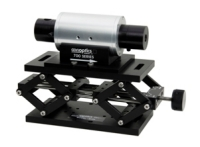

This then adds to a total of 90° when the light travels in the forward direction and then the negative direction. This is due to the change in the relative magnetic field direction, positive one way, negative the other. In the reverse direction, the rotation is −45°. So in the forward direction, the rotation is positive 45°. That is, the polarization rotation due to the Faraday rotator is always in the same relative direction. Optical isolators are different from 1/4 wave plate based isolators because the Faraday rotator provides non-reciprocal rotation while maintaining linear polarization. Commercial YIG based Faraday isolators reach isolations higher than 30 dB. For long distance fibre communication, typically at 1310 nm or 1550 nm, yttrium iron garnet crystals are used (YIG). The two most commonly used materials for the 700–1100 nm range are terbium doped borosilicate glass and terbium gallium garnet crystal (TGG). Also, to prevent self-focusing and other thermal related effects, the optic should be as short as possible.

The characteristics that one looks for in a Faraday rotator optic include a high Verdet constant, low absorption coefficient, low non-linear refractive index and high damage threshold. The most important optical element in an isolator is the Faraday rotator. The rays were traced using an ordinary refractive index of 2, and an extraordinary refractive index of 3. The forward travelling light is shown in blue, and the backward propagating light is shown in red. In the isolated direction the beam is split, and then diverged, so it does not focus at the collimator.įigure 3 shows the propagation of light through a polarization independent isolator. In the transmitted direction the beam is split and then combined and focused into the output collimator. Typically collimators are used on either side of the isolator. Instead of being focused by the second birefringent wedge, the rays diverge. Now the o-ray is at 90°, and the e-ray is at 0°. The Faraday Rotator again rotates both the rays by 45°. Light traveling in the backward direction is separated into the o-ray at 45, and the e-ray at −45° by the birefringent wedge. The output birefringent wedge then recombines the two components. This means the o-ray is now at 45°, and the e-ray is at −45°. The Faraday rotator rotates both the o-ray and e-ray by 45°. Light traveling in the forward direction is split by the input birefringent wedge into its vertical (0°) and horizontal (90°) components, called the ordinary ray (o-ray) and the extraordinary ray (e-ray) respectively. The polarization independent isolator is made of three parts, an input birefringent wedge (with its ordinary polarization direction vertical and its extraordinary polarization direction horizontal), a Faraday rotator, and an output birefringent wedge (with its ordinary polarization direction at 45°, and its extraordinary polarization direction at −45°). Hence the angle of polarization will lead to a loss.įigure 3: Polarization independent isolator In optical fibre systems, the polarization direction is typically dispersed in non polarization maintaining systems. This is because the polarization of the source is typically maintained by the system.
#Uses for an optical isolator free#
Polarization dependent isolators are typically used in free space optical systems. The Faraday rotator is chosen to give a 45° rotation. The main component of the optical isolator is the Faraday rotator.


 0 kommentar(er)
0 kommentar(er)
